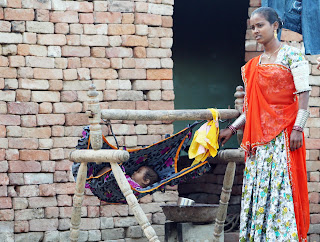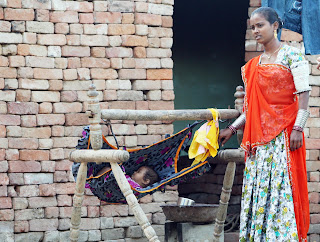A Mother’s Love: A
Lullaby on the Road (with #Motherhood
and #Gypsy Culture)
While wandering
through the vibrant Vautha Mela, a peasant fair deep within Gujarat, a scene
captured my heart. A young Gypsy mother, her voice humming a gentle lullaby,
stood beside a makeshift palanquin. Inside, nestled comfortably, lay her tiny
child. With a rhythmic tenderness, she swayed the palanquin, creating a
soothing cradle for her precious cargo.
As a newcomer
to the area, I didn’t want to intrude upon this intimate moment. Using a long
zoom lens, I discreetly captured a few photographs, forever etching this scene
of maternal love into my memory.
The Gypsy
community embodies the spirit of nomadism, moving from place to place, setting
up temporary camps, and then journeying onwards. This unique lifestyle fosters
a deep connection between mother and child.
From the first
few months, a newborn begins to recognize its mother’s voice. This powerful
bond strengthens over time, with visual recognition developing around 2-4 months.
Even before birth, a child can be soothed by the familiar rhythm of their
mother’s voice. Scent also plays a role, particularly during breastfeeding. A
child’s response to their mother’s presence – a smile, a coo, a turn of the
head – is a testament to this incredible bond.
A mother’s
desire for her child’s well-being is boundless. A strong emotional connection
acts as a shield, protecting a child from life’s inevitable challenges.
Discipline should be tempered with love and playfulness. Even single mothers
can find a strength akin to a father figure, ensuring their child’s balanced
growth.
A mother’s
contributions are immeasurable. Her tireless efforts for her child and family
are a debt that can never be fully repaid.
Palanquins,
though rarely seen in modern times, still hold a place in India’s heritage. In
remote areas, from the villages nestled within the Sundarbans to the rural
heartland, these traditional modes of transport can still be found. Bollywood
films often pay homage to this bygone era.
Palanquin
bearers typically come from underprivileged backgrounds. In Bihar, for example,
they can be found at religious sites like Rajgir and Gaya, assisting elderly
pilgrims or tourists navigate the challenging terrain. Their service comes at a
fair price.
The story of
the palanquin isn’t just about luxury; it’s about resilience. During monsoon
season in Chhattisgarh, villagers once fashioned a makeshift palanquin to carry
a sick woman 6 kilometers to the nearest hospital. This ingenuity highlights
the enduring usefulness of this ancient mode of transport, proving its place in
certain corners of our country.
In the Photo: A Gypsy mother cradles her child in a
lovingly crafted palanquin.
Text and Photo
by Ashok Karan, Ashokkaran.blogspot.com
Please like,
share, and subscribe!
#Motherhood
#GypsyCulture



Leave a Reply